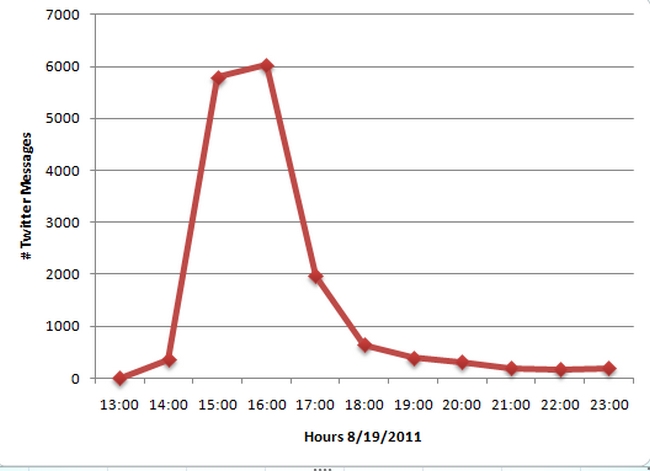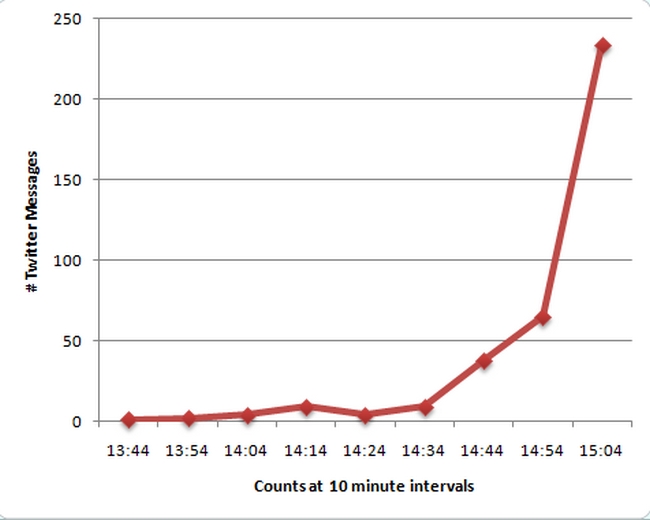
#TellBashar2Go
The leaders of the world finally got their act together and President Obama announced their conclusion -- Assad must go. The response of Syrians and friends of Syrians was a torrent of Twitter messages using the hashtag #Tell Bahsar2Go.
The messages started slowly.
 |
The first hour there were only 363 messages, but it exploded to just under and just over 6,000 messages at 15:00 and 16:00 [Syrian time]. It dropped to 2,000 at 17:00 and then dropped to a few hundred per hour for the rest of the day. The number of messages containing #TellBashar2Go for the day was 16,066. While it continued to be tweeted the following day it never rose to more than 100 per hour. It was a brief spike in the flow of messages about Syria.
Going viral is one way to characterize the stream of messages; #TellBashar2Go was going viral. [Boynton, 2010 and Boynton, 2011] That was not the language of the participants, however. They were interested in 'trending.' One of the very early messages mentioning trending was
curioustip 8/19/2011 15:28:00 pm RT @haloefekti: OK. #Syria Campaign has started. Let's put #TellBashar2Go to your tweets next 2 hours and send it to be a trending topic worldwide
And in only a few minutes they had made it
eemasaurusrex 8/19/2011 15:39:00 pm OMGGGGGG THIS IS SOOOOOOO FREAKING COOOL!!!!! #TellBashar2Go is trending worldwideeeeee!!!!!!!!!!!!!! #Syria #ThankYouGod
Until Twitter became dominant 'going viral' was the favorite language for characterizing a burst like this. Twitter's recognition of trending subjects has changed the language. Trending was mentioned 723 times in this stream of messages; going viral zero.
Trending reminds us of an obvious point about a difference between going viral in social relations and going viral in epidemics. Most people who are diseased in an epidemic did not want to be in that state. But for Twitter messages you need to want to communicate the message. This was a large number of people who wanted to call on themselves and the world to tell Bashar to go.
However, neither characterization is very helpful in explicating how the distribution in time came to be what it was. That is what I want to look at.
This is where it started:
GotFreedomSY: EVERY1! OUR NEW HASHTAG IS #TellBashar2Go! PLEASE RT THIS TWEET BUT DON'T START TWEETING THE HASHTAG UNTIL OUR EVENT STARTS IN 2 HRS! #Syria
At 13:40 the word was -- our new hashtag is #TellBashar2Go, but don't push it for two hours. They did not wait a full two hours. At 14:58 the word was
@essamz Worldwide twitter campaign 4 #Syria starts now.. Use hash tag #TellBashar2Go
RT @Nora0315: OK EVERYONE! TWITTER CAMPAIGN HAS OFFICIALLY BEGUN. FOR THE NEXT 2 HOURS PLEASE ADD #TellBashar2Go TO ALL YOUR TWEETS! PLEASE RT! #Syria
The second figure shows the numbers of messages posted between the two time points.
 |
The first 10 minutes there was one Twitter message containing #TellBashar2Go. Then 2, then 4, and 9 and 4 and 9, and it takes off with 38 and 65 and finally 234. After that comes the explosion. How do 366 messages inspire the spike of 16,000 messages?
Every one of the 366 messages was available to some number of followers. I counted all of the followers of the people posting messages that contained #TellBashar2Go between 13:42 and 14:59. One hundred and twelve persons posted a message. Their followers numbered 55,015. From 112 people the 'word' went out to 55,015. In one hour 55,015 people had access to a message calling on them to post a message containing the hashtag.
There is a second way to count the preparation for the Twitter campaign. A number of the people posted more than one message. The number of messages posted during that time was 111,958. The ratio of number of followers to number of messages could be called the 'commotion' in the message stream. That ratio is 2 to 1; two messages for each follower. We do not know whether that ratio is large or small. It becomes a subject for future research.
Conclusion
In an hour a campaign was organized that produced 16,000 Twitter messages in an afternoon and evening. The organization took place in 'public.' It was a few hundred Twitter messages. But those few hundred messages were organizationally potent because of already established follower relationships. Unless you are looking at follower relationships it seems only a few hundred messages. So what? The what is in the right circumstances those few hundred messages can be quite potent organizationally. And it is easy to miss when only paying attention to the flow.
References
Boynton (2010) Going Viral -- in the small
Boynton (2011) Now that's going viral: #ScariestWordsEver "President Palin"
© G. R. Boynton, 2011